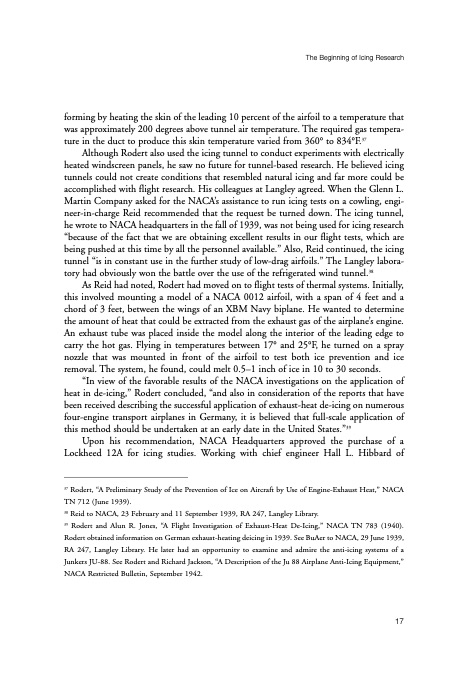
PDF Publication Title:
Text from PDF Page: 030
forming by heating the skin of the leading 10 percent of the airfoil to a temperature that was approximately 200 degrees above tunnel air temperature. The required gas tempera- ture in the duct to produce this skin temperature varied from 360° to 834°F.37 Although Rodert also used the icing tunnel to conduct experiments with electrically heated windscreen panels, he saw no future for tunnel-based research. He believed icing tunnels could not create conditions that resembled natural icing and far more could be accomplished with flight research. His colleagues at Langley agreed. When the Glenn L. Martin Company asked for the NACA’s assistance to run icing tests on a cowling, engi- neer-in-charge Reid recommended that the request be turned down. The icing tunnel, he wrote to NACA headquarters in the fall of 1939, was not being used for icing research “because of the fact that we are obtaining excellent results in our flight tests, which are being pushed at this time by all the personnel available.” Also, Reid continued, the icing tunnel “is in constant use in the further study of low-drag airfoils.” The Langley labora- tory had obviously won the battle over the use of the refrigerated wind tunnel.38 As Reid had noted, Rodert had moved on to flight tests of thermal systems. Initially, this involved mounting a model of a NACA 0012 airfoil, with a span of 4 feet and a chord of 3 feet, between the wings of an XBM Navy biplane. He wanted to determine the amount of heat that could be extracted from the exhaust gas of the airplane’s engine. An exhaust tube was placed inside the model along the interior of the leading edge to carry the hot gas. Flying in temperatures between 17° and 25°F, he turned on a spray nozzle that was mounted in front of the airfoil to test both ice prevention and ice removal. The system, he found, could melt 0.5–1 inch of ice in 10 to 30 seconds. “In view of the favorable results of the NACA investigations on the application of heat in de-icing,” Rodert concluded, “and also in consideration of the reports that have been received describing the successful application of exhaust-heat de-icing on numerous four-engine transport airplanes in Germany, it is believed that full-scale application of this method should be undertaken at an early date in the United States.”39 Upon his recommendation, NACA Headquarters approved the purchase of a Lockheed 12A for icing studies. Working with chief engineer Hall L. Hibbard of The Beginning of Icing Research 37 Rodert, “A Preliminary Study of the Prevention of Ice on Aircraft by Use of Engine-Exhaust Heat,” NACA TN 712 (June 1939). 38 Reid to NACA, 23 February and 11 September 1939, RA 247, Langley Library. 39 Rodert and Alun R. Jones, “A Flight Investigation of Exhaust-Heat De-Icing,” NACA TN 783 (1940). Rodert obtained information on German exhaust-heating deicing in 1939. See BuAer to NACA, 29 June 1939, RA 247, Langley Library. He later had an opportunity to examine and admire the anti-icing systems of a Junkers JU-88. See Rodert and Richard Jackson, “A Description of the Ju 88 Airplane Anti-Icing Equipment,” NACA Restricted Bulletin, September 1942. 17PDF Image | History of NASA Icing Research Tunnel

PDF Search Title:
History of NASA Icing Research TunnelOriginal File Name Searched:
sp4226.pdfDIY PDF Search: Google It | Yahoo | Bing
NFT (Non Fungible Token): Buy our tech, design, development or system NFT and become part of our tech NFT network... More Info
IT XR Project Redstone NFT Available for Sale: NFT for high tech turbine design with one part 3D printed counter-rotating energy turbine. Be part of the future with this NFT. Can be bought and sold but only one design NFT exists. Royalties go to the developer (Infinity) to keep enhancing design and applications... More Info
Infinity Turbine IT XR Project Redstone Design: NFT for sale... NFT for high tech turbine design with one part 3D printed counter-rotating energy turbine. Includes all rights to this turbine design, including license for Fluid Handling Block I and II for the turbine assembly and housing. The NFT includes the blueprints (cad/cam), revenue streams, and all future development of the IT XR Project Redstone... More Info
Infinity Turbine ROT Radial Outflow Turbine 24 Design and Worldwide Rights: NFT for sale... NFT for the ROT 24 energy turbine. Be part of the future with this NFT. This design can be bought and sold but only one design NFT exists. You may manufacture the unit, or get the revenues from its sale from Infinity Turbine. Royalties go to the developer (Infinity) to keep enhancing design and applications... More Info
Infinity Supercritical CO2 10 Liter Extractor Design and Worldwide Rights: The Infinity Supercritical 10L CO2 extractor is for botanical oil extraction, which is rich in terpenes and can produce shelf ready full spectrum oil. With over 5 years of development, this industry leader mature extractor machine has been sold since 2015 and is part of many profitable businesses. The process can also be used for electrowinning, e-waste recycling, and lithium battery recycling, gold mining electronic wastes, precious metals. CO2 can also be used in a reverse fuel cell with nafion to make a gas-to-liquids fuel, such as methanol, ethanol and butanol or ethylene. Supercritical CO2 has also been used for treating nafion to make it more effective catalyst. This NFT is for the purchase of worldwide rights which includes the design. More Info
NFT (Non Fungible Token): Buy our tech, design, development or system NFT and become part of our tech NFT network... More Info
Infinity Turbine Products: Special for this month, any plans are $10,000 for complete Cad/Cam blueprints. License is for one build. Try before you buy a production license. May pay by Bitcoin or other Crypto. Products Page... More Info
| CONTACT TEL: 608-238-6001 Email: greg@infinityturbine.com | RSS | AMP |